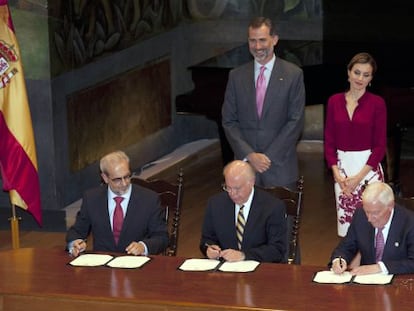Four tests in three hours to check your official level of Spanish
Modeled on the TOEFL, the new SIELE language exam is due to be launched next year

As of September 2016, students of Spanish will be able to sit a single proficiency exam that aims to represent the many variants of the language, which is spoken around the world by more than half-a-billion people.
Modeled on the TOEFL and IELTS English exams, the International Spanish Language Evaluation Service (SIELE) is the brainchild of the Instituto Cervantes, the government-funded agency responsible for promoting Spanish around the world, and has been developed in conjunction with the University of Salamanca, the National Autonomous University of Mexico, along with Telefónica, which is responsible for the technological platform.
SIELE is aimed at the 21 million students of Spanish around the world, as well as native speakers
The SIELE test will be taken online at accredited centers and will assess students’ knowledge of Spanish. They will then receive a certificate that will be valid for two years.
As opposed to the English exams it is patterned after, the SIELE will take into account different linguistic varieties of Spanish. For example, where the TOEFL tests only in American English, and Cambridge Exams test in British English, the SIELE will incorporate within a single exam the many different geographical variations of Spanish, a language that differs greatly from nation to nation.
SIELE is aimed at the 21 million students of Spanish around the world, as well as native speakers. Rather than passing or failing, students are simply given a score, up to a maximum of 1,000 points, which places them on one of six levels equivalent to EU-established guidelines. Assessments will be made based on reading, listening, writing and speaking.
Candidates can sit the entire exam in one go, or they can opt to take one or more of the four tests independently, receiving reports on their respective levels.
Some 300,000 people are expected to sit the exam in the first phase, from September 2016. Within five years, that number is likely to rise to 750,000. A number of Spanish language exams already exist, but SIELE aims to set the benchmark.
“It is the fastest accreditation system and the most universal,” said Instituto Cervantes director Víctor García de la Concha at a signing ceremony in Madrid on Thursday.
Some 300,000 people are expected to sit the exam in the first phase, and within five years, that number is likely to rise to 750,000
The Instituto de Cervantes has 92 schools in 44 countries, although its presence in Asia is limited to a single center in China, according to García de la Concha.
China, Brazil and the United States
The first phase of SIELE will focus mainly on China, where some 60 centers are due to open over a three-year period, as well as Brazil, with some 120 centers, and in the United States, where around 100 centers are due to open. The certificate is “conceived with the aim of spreading knowledge of Spanish and to accredit it,” said García de la Concha.
Universities throughout the Spanish-speaking world are invited to take part in the project, added García de la Concha. Education Minister Íñigo Méndez de Vigo highlighted what he called the “pan-Hispanic vision of the language, while José Manuel García Margallo, Minister of Foreign Affairs, described the event as “one of the most important” since he took office, adding: “The spread of Spanish online has only just begun.”
Speaking in June at the official launch of SIELE, Spain’s King Felipe described the test as “pan-Hispanic” in character. He added the new certificate would extend the global reach of Spanish, which he described to the audience as a heritage that “we must all look after, disseminate and promote.”
A four-part exam
The SIELE exam consists of four parts: reading, listening, speaking and writing. The test will be computer based, and administered year-round at a network of global test centers.
The complete exam will take around three hours to sit, although it is possible to take each component separately. No price has yet been set.
Instead of a pass or fail, exam sitters will be given a score out of a maximum of 1,000 points. The result will have its equivalent within the EU’s six-level European Reference Framework.
The exam will be taken in accredited centers to be opened throughout the world. Examiners will be accredited and trained by the Instituto de Cervantes, the University of Salamanca, and the National Autonomous University of Mexico.
Tu suscripción se está usando en otro dispositivo
¿Quieres añadir otro usuario a tu suscripción?
Si continúas leyendo en este dispositivo, no se podrá leer en el otro.
FlechaTu suscripción se está usando en otro dispositivo y solo puedes acceder a EL PAÍS desde un dispositivo a la vez.
Si quieres compartir tu cuenta, cambia tu suscripción a la modalidad Premium, así podrás añadir otro usuario. Cada uno accederá con su propia cuenta de email, lo que os permitirá personalizar vuestra experiencia en EL PAÍS.
¿Tienes una suscripción de empresa? Accede aquí para contratar más cuentas.
En el caso de no saber quién está usando tu cuenta, te recomendamos cambiar tu contraseña aquí.
Si decides continuar compartiendo tu cuenta, este mensaje se mostrará en tu dispositivo y en el de la otra persona que está usando tu cuenta de forma indefinida, afectando a tu experiencia de lectura. Puedes consultar aquí los términos y condiciones de la suscripción digital.
More information
Últimas noticias
Reinhard Genzel, Nobel laureate in physics: ‘One-minute videos will never give you the truth’
Pinochet’s victims grapple with José Antonio Kast’s rise in Chile
How Japan is trying to avert ‘digital defeat’
The complicated life of Francesca Albanese: A rising figure in Italy but barred from every bank by Trump’s sanctions
Most viewed
- Pablo Escobar’s hippos: A serious environmental problem, 40 years on
- Why we lost the habit of sleeping in two segments and how that changed our sense of time
- Charles Dubouloz, mountaineering star, retires at 36 with a farewell tour inspired by Walter Bonatti
- Trump’s obsession with putting his name on everything is unprecedented in the United States
- The Florida Keys tourist paradise is besieged by immigration agents: ‘We’ve never seen anything like this’










































